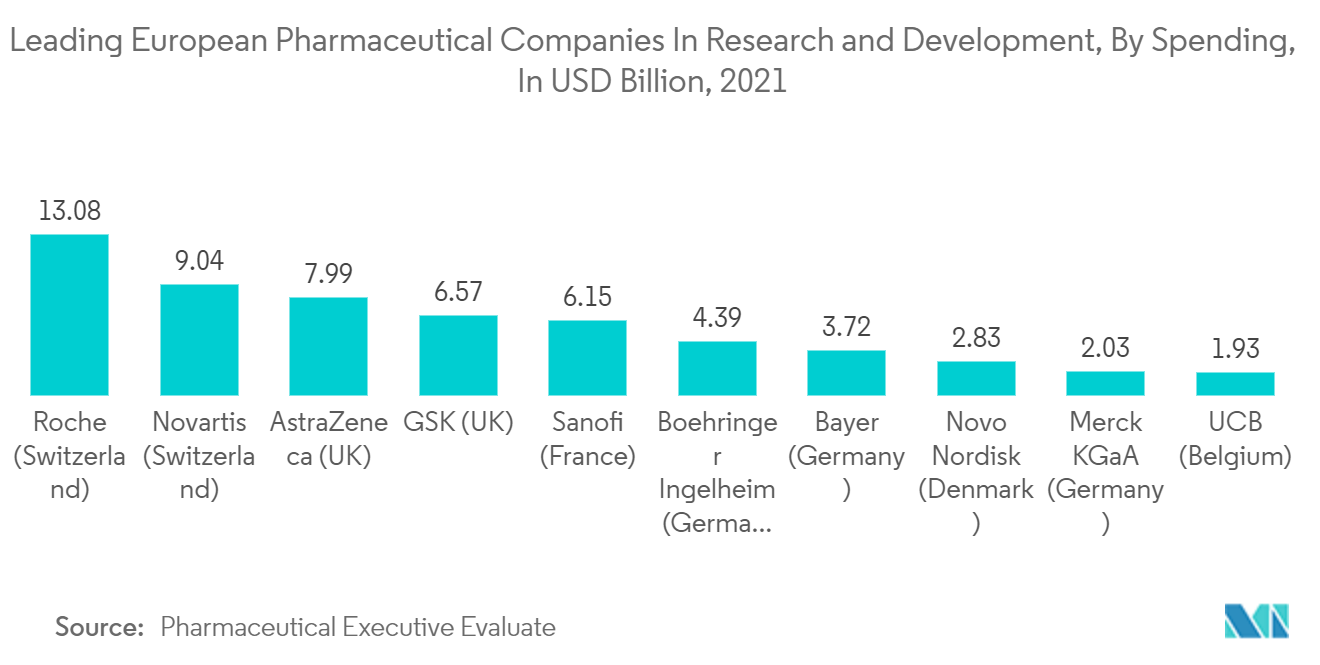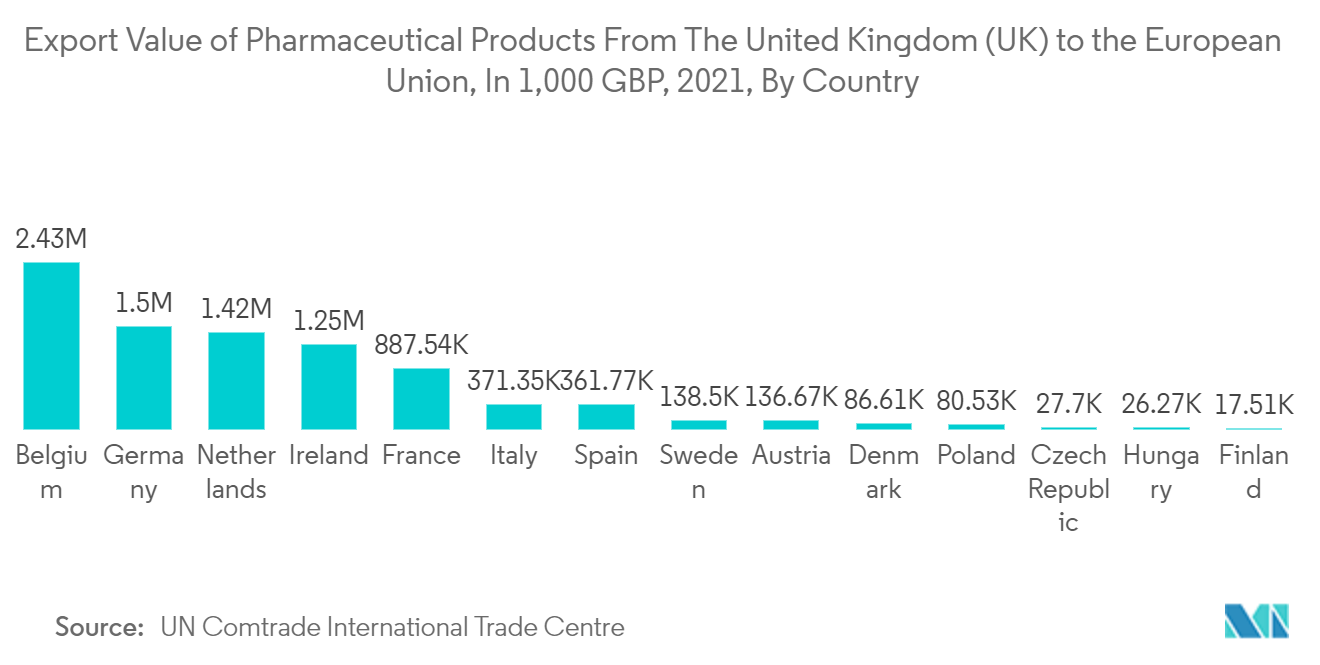Market Trends of Europe Pharmaceutical Contract Manufacturing Industry
This section covers the major market trends shaping the Europe Pharmaceutical Contract Manufacturing Market according to our research experts:
Rising Investment in R&D will Drive The Market Growth
- The market of Europe pharmaceutical contract manufacturing is growing due to the recent crises highlighted and the critical need for Europe to secure and strengthen its position as the leader in medical innovation. As the European Commission works on reviewing the Pharmaceutical Legislation, corporate pharmaceutical R&D expenditure is growing in Europe.
- Covid-19 highlighted some important flaws with how the pharmaceutical business decides what research and development projects to prioritize. Present policies for public funding of pharmaceutical research and market regulation also influence such criticalities in determining investment priorities and their effectiveness and efficiency.
- Recently the European Commission published a roadmap for a European pharmaceutical strategy, and the Commission adopted related communication. The strategy aims to ensure Europe's supply of safe and affordable medicines and support the European pharmaceutical industry's innovation efforts. As the European Commission President advocates, building a more robust European Health Union is crucial.
- With a focus on research and development in the area of innovative medicines, European Medicines Infrastructure includes building a portfolio of innovative pharmaceutical R&D projects in selected pharmaceutical areas and related biomedical fields in the upcoming year.
- A growing number of people are worried about the high costs of cutting-edge medications, access, and availability restrictions, and the pressure on global healthcare budgets. Examining the underlying research and development (R&D) system that generates these results is necessary for addressing these difficulties.
- Moreover, according to EFPIA, research-based pharmaceutical industry can play a critical role in restoring Europe to growth and ensuring future competitiveness in an advancing global economy. In 2021 it invested an estimated EUR 41,500 million (USD 43,17 million) in R&D in Europe.
- The pharmaceutical industry is also the sector with the highest ratio of R&D investment to net sales. According to the 2021 EU Industrial R&D Investment Scoreboard, health industries invested about EUR188.7 billion (USD 194.78 billion) in R&D, accounting for 20.8% of total business R&D expenditure worldwide.
- The fragmentation of the EU pharmaceutical market has resulted in a lucrative parallel trade. This benefits neither social security nor patients and deprives the industry of additional resources to fund R&D. Parallel trade was estimated to amount to EUR 6,070 million (USD 6.30 million).
- Most players are acquiring allied injectable manufacturing companies to increase their manufacturing capabilities. The United Kingdom's pharmaceutical industry is one of the country's significant engines of innovation and research. The industry is spending billions of dollars on R&D and employing many people for highly skilled R&D roles.

Increasing Export of Pharmaceutical Products from United Kingdom
- The United Kingdom will likely remain the most significant contract manufacturing market in Europe in terms of capacity and market share. One of the factors attracting pharmaceutical manufacturers to outsource production to this region is highly skilled and specialized employees, which is vital for manufacturing Highly Potent APIs (HPAPIs).
- Drug prices are lower in European countries, as the government reimburses a significant portion of drug costs. Due to favorable reimbursement policies and higher margins, the injectables segment is expected to record higher growth rates over other FDF manufacturing segments.
- In the United Kingdom, the substantial growth of injectables in the CMO market results from strong IP regulations and expertise, while solid, semi-solid, and liquid dose formulations face competition from emerging markets.
- According to EUROSTAT, the pharmaceutical industry is the high-technology sector with the highest added value per person employed, significantly higher than the average value for the high-tech and manufacturing industries. The pharmaceutical industry is also the sector with the highest ratio of R&D investment to net sales.
- Along with the leading manufacturing countries, such as Germany, Japan, and the United States, the United Kingdom has increasingly specialized in higher technology manufacturing industries, such as pharmaceuticals. The United Kingdom's pharmaceutical and life sciences sector has pitched up well in the face of the Covid crisis, with robust capitalization providing the structure for continued momentum despite the downturn. It was due to the backdrop of innovation, aided by a complex and wide-ranging network of government support, financial incentives, and other collaboration with research institutions and the National Health Service (NHS).
- However, NHS leaders and medical charities are heading to ministers to bring more drug manufacturing to the UK to reduce the risk of future shortages coming. In addition to the well-documented need for personal protective equipment, dealing with COVID-19 has strained the supplies of intensive care medicine, over-the-counter drugs, and oxygen. NHS was forced to put new rationing measures in place to ensure hospitals do not run out
- Many market players are investing heavily to expand their manufacturing capacities. For instance, in June 2021, FUJIFILM Corporation announced plans to invest USD 850 million into accelerating the growth of its subsidiary, FUJIFILM Diosynth Biotechnologies. This investment is targeted to increase the capacity of biologics, including recombinant vaccines for COVID-19 and advanced gene therapies in the United Kingdom.
- Moreover, in March 2022, Sterling Pharma Solutions UK, a global contract development and manufacturing organization (CDMO), reached an agreement with Novartis to acquire its Ringaskiddy campus (Novartis Ringaskiddy Limited), Ireland. Sterling will acquire the 111-acre site, which includes 3 active pharmaceutical ingredients (API) manufacturing buildings and facilities to support the development and scale-up in line with Sterling's core business focus.
- These massive investments and the proportion of skilled workers show how the United Kingdom is building the pipeline of medicines and future drugs. This is an excellent opportunity for CMOs, as companies that focus on R&D often outsource their manufacturing operations for better efficiency.
- In June 2021, Onyx Scientific, a small molecule API CDMO, announced the receipt of a commercial API license for its UK facility, granted by the Medicines and Healthcare Products Regulatory Agency. The license enables the company to support API projects from pre-clinical studies to commercial production.
- Moreover, the political aspect of the country, in terms of transitioning from the EU, poses challenges among contract-based manufacturers. This relates to new regulations and requirements for the UK/EU-based CMOs, as they will have to follow rigorous testing of multiple products under two regulatory frameworks.
- However, as laid out in the 'Acquis Communautaire,' EU pharmaceutical law continues to apply to the United Kingdom. This enables pharmaceutical companies to carry out activities in the country. Also, the UK is a significant exporter of pharmaceuticals. Following the closure of Pfizer's research facility at Sandwich in Kent, after a loss of 2,000 jobs, the UK government took a more assertive stance to incentivize pharmaceutical outsourcing within the country, along with R&D, through several key measures.
- Further, the UK pharmaceutical industry is one of the country's significant engines of innovation and research. The industry is spending billions of dollars on R&D and employing vast numbers for highly skilled R&D roles. According to ABPI (Association of the British Pharmaceutical Industry), out of 73,000 people employed directly by the pharmaceutical industry, 23,000 work for R&D.

